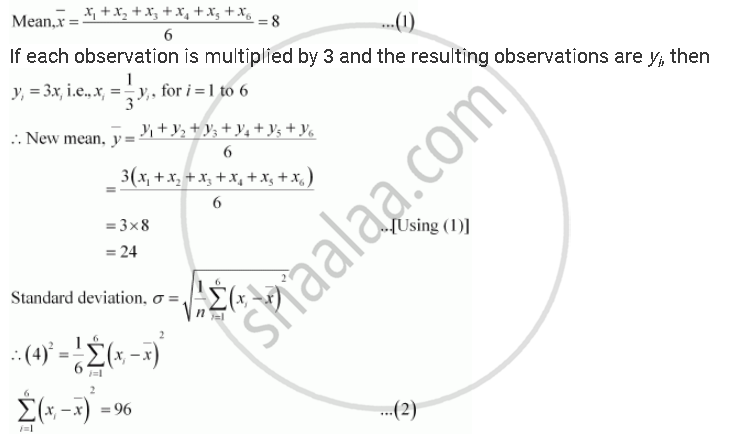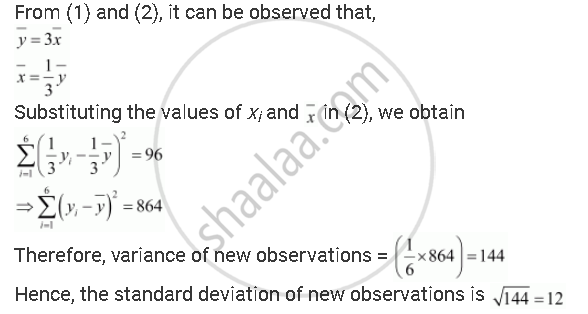Advertisements
Advertisements
प्रश्न
The mean and standard deviation of six observations are 8 and 4, respectively. If each observation is multiplied by 3, find the new mean and new standard deviation of the resulting observations
उत्तर
Let the observations be x1, x2, x3, x4, x5, and x6.
It is given that mean is 8 and standard deviation is 4.


APPEARS IN
संबंधित प्रश्न
Find the mean and variance for the first n natural numbers.
Find the mean and variance for the data.
| xi | 6 | 10 | 14 | 18 | 24 | 28 | 30 |
| fi | 2 | 4 | 7 | 12 | 8 | 4 | 3 |
The diameters of circles (in mm) drawn in a design are given below:
| Diameters | 33 - 36 | 37 - 40 | 41 - 44 | 45 - 48 | 49 - 52 |
| No. of circles | 15 | 17 | 21 | 22 | 25 |
Calculate the standard deviation and mean diameter of the circles.
[Hint: First make the data continuous by making the classes as 32.5 - 36.5, 36.5 - 40.5, 40.5 - 44.5, 44.5 - 48.5, 48.5 - 52.5 and then proceed.]
The sum and sum of squares corresponding to length x (in cm) and weight y (in gm) of 50 plant products are given below:
`sum_(i-1)^50 x_i = 212, sum_(i=1)^50 x_i^2 = 902.8, sum_(i=1)^50 y_i = 261, sum_(i = 1)^50 y_i^2 = 1457.6`
Which is more varying, the length or weight?
The mean and variance of 7 observations are 8 and 16, respectively. If five of the observations are 2, 4, 10, 12 and 14. Find the remaining two observations.
Given that `barx` is the mean and σ2 is the variance of n observations x1, x2, …,xn. Prove that the mean and variance of the observations ax1, ax2, ax3, …,axn are `abarx` and a2 σ2, respectively (a ≠ 0).
Find the mean, variance and standard deviation for the data:
2, 4, 5, 6, 8, 17.
Find the mean, variance and standard deviation for the data:
6, 7, 10, 12, 13, 4, 8, 12.
Find the mean, variance and standard deviation for the data:
227, 235, 255, 269, 292, 299, 312, 321, 333, 348.
Find the mean, variance and standard deviation for the data 15, 22, 27, 11, 9, 21, 14, 9.
The variance of 20 observations is 5. If each observation is multiplied by 2, find the variance of the resulting observations.
The variance of 15 observations is 4. If each observation is increased by 9, find the variance of the resulting observations.
The mean and standard deviation of 6 observations are 8 and 4 respectively. If each observation is multiplied by 3, find the new mean and new standard deviation of the resulting observations.
The mean and variance of 8 observations are 9 and 9.25 respectively. If six of the observations are 6, 7, 10, 12, 12 and 13, find the remaining two observations.
The mean and standard deviation of 100 observations were calculated as 40 and 5.1 respectively by a student who took by mistake 50 instead of 40 for one observation. What are the correct mean and standard deviation?
The mean and standard deviation of 20 observations are found to be 10 and 2 respectively. On rechecking it was found that an observation 8 was incorrect. Calculate the correct mean and standard deviation in each of the following cases:
(i) If wrong item is omitted
(ii) if it is replaced by 12.
The mean and standard deviation of a group of 100 observations were found to be 20 and 3 respectively. Later on it was found that three observations were incorrect, which were recorded as 21, 21 and 18. Find the mean and standard deviation if the incorrect observations were omitted.
Show that the two formulae for the standard deviation of ungrouped data
\[\sigma = \sqrt{\frac{1}{n} \sum \left( x_i - X \right)^2_{}}\] and
\[\sigma' = \sqrt{\frac{1}{n} \sum x_i^2 - X^2_{}}\] are equivalent, where \[X = \frac{1}{n}\sum_{} x_i\]
Calculate the mean and S.D. for the following data:
| Expenditure in Rs: | 0-10 | 10-20 | 20-30 | 30-40 | 40-50 |
| Frequency: | 14 | 13 | 27 | 21 | 15 |
The weight of coffee in 70 jars is shown in the following table:
| Weight (in grams): | 200–201 | 201–202 | 202–203 | 203–204 | 204–205 | 205–206 |
| Frequency: | 13 | 27 | 18 | 10 | 1 | 1 |
Determine the variance and standard deviation of the above distribution.
Mean and standard deviation of 100 observations were found to be 40 and 10 respectively. If at the time of calculation two observations were wrongly taken as 30 and 70 in place of 3 and 27 respectively, find the correct standard deviation.
Coefficient of variation of two distributions are 60% and 70% and their standard deviations are 21 and 16 respectively. What are their arithmetic means?
The mean and standard deviation of marks obtained by 50 students of a class in three subjects, mathematics, physics and chemistry are given below:
| Subject | Mathematics | Physics | Chemistry |
| Mean | 42 | 32 | 40.9 |
| Standard Deviation | 12 | 15 | 20 |
Which of the three subjects shows the highest variability in marks and which shows the lowest?
A set of n values x1, x2, ..., xn has standard deviation 6. The standard deviation of n values x1 + k, x2 + k, ..., xn + k will be ______.
The mean and standard deviation of a set of n1 observations are `barx_1` and s1, respectively while the mean and standard deviation of another set of n2 observations are `barx_2` and s2, respectively. Show that the standard deviation of the combined set of (n1 + n2) observations is given by
S.D. = `sqrt((n_1(s_1)^2 + n_2(s_2)^2)/(n_1 + n_2) + (n_1n_2 (barx_1 - barx_2)^2)/(n_1 + n_2)^2)`
If for distribution `sum(x - 5)` = 3, `sum(x - 5)^2` = 43 and total number of items is 18. Find the mean and standard deviation.
Mean and standard deviation of 100 observations were found to be 40 and 10, respectively. If at the time of calculation two observations were wrongly taken as 30 and 70 in place of 3 and 27 respectively, find the correct standard deviation.
Let x1, x2, x3, x4, x5 be the observations with mean m and standard deviation s. The standard deviation of the observations kx1, kx2, kx3, kx4, kx5 is ______.
If the variance of a data is 121, then the standard deviation of the data is ______.
The mean and standard deviation of six observations are 8 and 4, respectively. If each observation is multiplied by 3, find the new mean and new standard deviation of the resulting observations.
